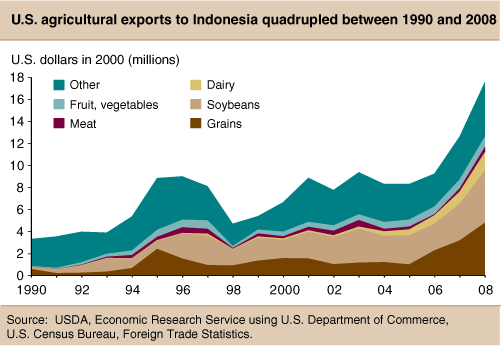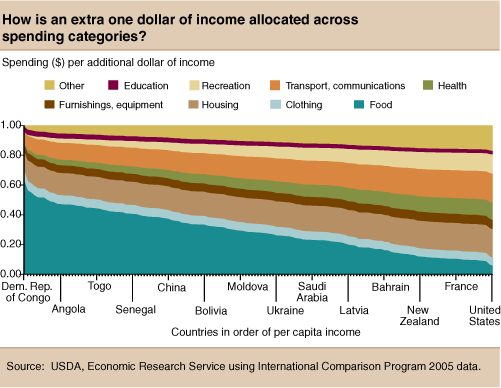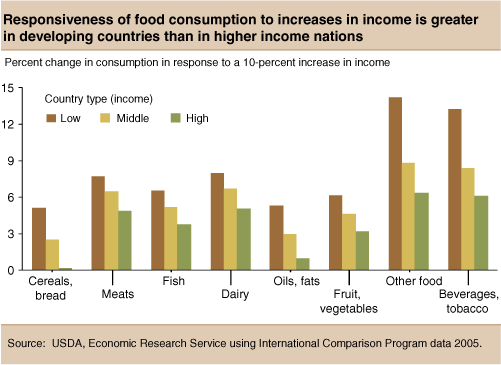Income Growth in Developing Countries Can Increase U.S. Agricultural Exports
- by Birgit Meade, Andrew Muhammad and Nicholas Rada
- 3/14/2011
Highlights
- Developing and middle-income countries are becoming increasingly important export markets for high-value agricultural products due to population, urbanization, and income growth.
- The U.S. agricultural export sector is well placed to meet the increasing demand for high-value food products, such as meat, dairy products, and prepared foods.
- In many developing countries, agricultural productivity growth is the strongest driver of income growth.
Income growth has increased food imports by developing countries, particularly since higher incomes strengthen the demand not only for traditional food but also for a more diversified diet. As a greater proportion of the world's population seeks to expand the quality and quantity of foods consumed, U.S. agricultural exports-such as feed and fodder and high--value foods--will continue to increase.
According to USDA long-term projections, developing countries will be the main source of projected growth in global food demand and trade. Food consumption in developing countries is considerably more responsive to income growth than in developed countries. Nearly 40 cents of an additional dollar of income will go to food in developing countries, compared with 10 cents in developed countries.
Developing Countries Are Important Markets for U.S. Agriculture
Strong income growth and rising populations in developing countries have increased demand for high-value food products, such as meats, dairy products, and a greater variety of fruit and vegetables, as well as a broad range of prepared foods. Growing urbanization also contributes to dietary changes. City dwellers are exposed to new food varieties, and their lifestyles often lead to less cooking and increased purchases of prepared foods.
Developing countries now account for more than half of all U.S. agricultural exports. Mexico and China are two major markets for U.S. agricultural exports, and countries such as India, Indonesia, and Colombia are becoming important export destinations. Among the large number of developing-country trading partners, 16 low- and middle-income countries account for 37 percent of U.S. agricultural exports, up from 15 percent in 1990. Since 1990, the average growth of U.S. exports to these countries has exceeded 10 percent annually.
While low- and middle-income countries are becoming increasingly important export markets for the U.S. agricultural sector, high-income markets are moving in the opposite direction. Nine high-income countries, most prominently Canada and Japan, accounted for 55 percent of U.S agricultural exports in 1990, but their share fell to 43 percent by 2008. Average annual growth in U.S. exports to these high-income countries was just 2.4 percent during that period.
Most high-income countries are reaching a point of food demand satiation. Average per capita consumption in high-income countries is close to 3,400 calories per day. The volume of food consumed is unlikely to increase considerably, and changes in diet composition will be marginal. Between 1990 and 2005, consumption patterns changed little in high-income countries. The share of staple foods, such as cereals and roots and tubers, remained at 29 percent of the average diet, and vegetable oils accounted for about 12 percent.
Consumption Patterns Changing in Developing and Middle-Income Countries
Staple foods averaged 60 percent of total food consumption in low-income countries and 42 percent in middle-income countries in 2005; however, those shares are declining. ERS researchers found that all countries are moving toward similar, more varied diets characterized by fewer staples and more meat, dairy, vegetable oils, and fruit and vegetable products (see "Converging Patterns in Global Food Consumption and Food Delivery Systems" in the February 2008 issue of Amber Waves).
Many low- and middle-income countries are not able to meet increased demand through domestic production and rely instead on the world market. For instance, as incomes have risen, demand for basic staples declined in Indonesia while dairy, fresh fruit, and other high-value imports from the United States increased. The volume of Indonesia's dairy imports from the United States grew more than 30 percent per year between 1998 and 2008. The quantity of snack food imports increased more than 20 percent annually, and fresh fruit, 17 percent. Imports of processed fruit and vegetables also grew steadily at close to 7 percent per year. India's agricultural imports from the United States have similarly increased, with fresh fruit imports gaining 57 percent annually from 1998 to 2008 and snack food imports 35 percent each year.
Staples or High-Value Products: How Is Additional Income Spent?
Governments, policymakers, businesses, food producers, market analysts, and others concerned with global food trends can better anticipate future import demand if they know how income growth affects food spending. ERS researchers estimated two different measures of the effect of income growth on food spending. The marginal share shows how much of an additional dollar of income in a particular country is spent on food or other consumption categories, such as housing or recreation. For example, in extremely poor countries like the Democratic Republic of Congo and Burundi, over half of this additional dollar is spent on food. For countries such as India, Indonesia, and Colombia, which account for an increasing share of U.S. agricultural exports, the portion of that extra dollar spent on food is between 28 and 39 cents. In high-income countries, less than 10 cents of that dollar--and only 4 cents in the U.S.--is spent on food.
A second measure--income elasticity--looks at the additional food or other spending as a result of a percentage increase in income rather than an across-the-board $1 increase. Obviously, one additional dollar in Tanzania is not the same as in the United States. Income elasticities are, therefore, a better measure of the responsiveness of demand to changes in income and are more comparable across countries. ERS researchers calculated these elasticities for broad consumption categories such as food, clothing, and housing, as well as for detailed food categories such as cereals, meats, dairy, and fruit and vegetables.
The ERS estimates were based on the 2005 International Comparison Program dataset, which covers 146 countries (2 countries were dropped in the ERS study) and offers a global perspective on consumption and food spending (see box, "The 2005 International Comparison Program Dataset"). For the analysis, ERS researchers divided the 144 countries into three income categories: low-income (having less than 15 percent of U.S. per capita income), middle-income (15-44 percent of U.S. per capita income), and high-income (greater than 45 percent of U.S. per capita income).
Low-income countries spend a smaller total amount but a much larger share of their incomes on food than both middle- and high-income countries. Households in Tanzania, for example, spend close to three-quarters of their income on food, while the share is about 12 percent in the U.S. Given that most food spending in low-income countries currently goes toward cereals and other staples, an income increase of 10 percent would raise spending on cereals (5 percent) by less than spending on meat and dairy (both 8 percent), which are considered high value and typically less affordable for households in low-income countries. In contrast, a 10-percent rise in income in high-income countries increases spending on meats and dairy by 5 percent each and on cereals by only 0.2 percent.
In most low-income countries, high-value food products and restaurant meals are luxury items--goods for which spending increases by a greater percentage than the increase in income. For example, a 10-percent increase in income in low-income countries boosts spending on high-value food items by 14 percent, more than twice the increase in high-income countries.
Agricultural Productivity as a Source of Income Growth
As developing-country incomes rise, the resulting increases in food demand may help expand U.S. agricultural export markets. But what are the catalysts for income growth in the poorest countries?
In a number of countries, improved domestic agricultural productivity is a strong driver of income growth. Many developing countries rely heavily on the agricultural sector for economic growth, and agricultural productivity growth plays a key role in reducing poverty and improving food security.
| Country | 1990 GDP per capita1 (2005 international dollars) | 2005 GDP per capita2 (2005 international dollars) | GDP per capita growth rate, 1990-2006 (percent) | Agricultural total factor productivity growth, 1990-2006 (percent) |
|---|---|---|---|---|
| China | 1,123 | 4,105 | 8.40 | 3.50 |
| Colombia | 4,943 | 5,910 | 1.50 | 2.40 |
| India | 1,185 | 2,225 | 4.20 | 1.60 |
| Indonesia | 2,089 | 3,212 | 3.20 | 1.90 |
| Mexico | 9,155 | 11,459 | 1.70 | 2.60 |
| U.S. | 31,630 | 41,774 | 1.75 | 1.79 |
| World average | 8,501 | 11,239 | 1.60 | 1.50 |
| Number of countries | 149 countries | 149 countries | 149 countries | 172 countries |
| Note: GDP = gross domestic product. An international dollar is a hypothetical currency that is used as a means of translating and comparing costs from one country to another using a common reference point, the U.S. dollar. 1 3-year average, 1989-91. 2 3-year average, 2004-06. Source: USDA, Economic Research Service using the World Bank's World Development Indicators, 2008; and "Total Factor Productivity in the Global Agricultural Economy: Evidence from FAO Data," by Keith Fuglie, in The Shifting Patterns of Agricultural Production and Productivity Worldwide, 2008. |
||||
Enhanced agricultural efficiency, through improved input quality or resource allocation, generates greater food availability, increases demand for industrial goods and services, and could result in higher export earnings. As agricultural productivity rises, a reinforcing cycle of supply and demand may be generated between agriculture and the rest of the economy, which can stimulate income growth. As agricultural efficiency improves, labor and capital are released to search out higher wages in other economic sectors, facilitating growth in the rest of the economy.
Developing countries such as India, Indonesia, and Colombia have achieved growth in agricultural productivity, while at the same time increasing U.S. agricultural imports. Agricultural productivity growth in these three countries from 1990 to 2006 was above the world average of 1.5 percent. During the same period, per capita gross domestic product (GDP) rose 4.2 percent in India, 3.2 percent in Indonesia, and 1.5 percent in Colombia, nearly matching or exceeding the global average of 1.6 percent.
As incomes rise, consumers purchase more higher value foods, including meat products. Increased demand for domestic meat, in turn, boosts demand for feed and fodder. Between 1998 and 2008, annual feed and fodder export volumes to Indonesia increased 28 percent, and those to India and Colombia increased 18 percent.
Developing Countries Will Strengthen Their Position as Important U.S. Agricultural Export Destinations
Future demand for agricultural products will increasingly come from developing countries, which have seen much higher income growth as a group than developed countries. Even during the recent worldwide recession, most developing countries were able to avoid the deep economic downturns experienced by many high-income countries. According to the International Monetary Fund, the GDP in emerging and developing countries grew 2.5 percent in 2009, while advanced economies shrank by more than 3 percent. Average annual growth in developing countries is projected at around 6.5 percent through 2015, compared with about 2.5 percent in advanced economies. Developing countries have faster growing populations and incomes, which are increasingly spent on high-value food products. The U.S. is well placed to compete in these new and expanding markets.
This article is drawn from:
- Regmi, A. & Gehlhar, M. (2005). New Directions in Global Food Markets. U.S. Department of Agriculture, Economic Research Service. AIB-794.
You may also like:
- Rada, N. & Regmi, A. (2010). Trade and Food Security Implications From the Indonesian Agricultural Experience. U.S. Department of Agriculture, Economic Research Service. WRS-10-01.
- International Evidence on Food Consumption Patterns. (2003). USDA, Economic Research Service. TB-1904.
- Converging Patterns in Global Food Consumption and Food Delivery Systems. (2008). USDA, Economic Research Service. Amber Waves, Vol. 6, Issue 1.
- Global Purchasing Power Parities and Real Expenditures: 2005 International Comparison Program. (2008). International Bank for Reconstruction and Development/World Bank.




